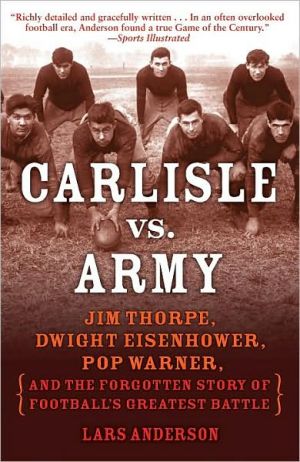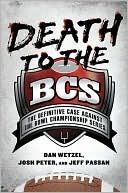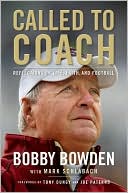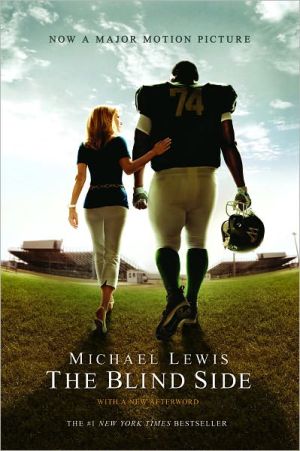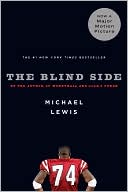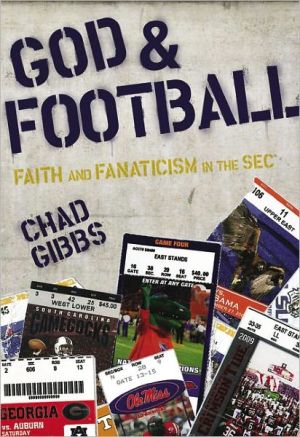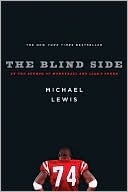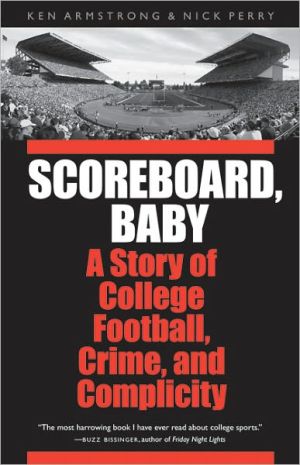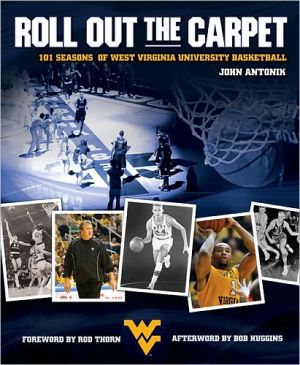Carlisle vs. Army: Jim Thorpe, Dwight Eisenhower, Pop Warner, and the Forgotten Story of Football's Greatest Battle
In this stunning work of narrative nonfiction, Lars Anderson recounts one of college football’s greatest contests: Carlisle vs. Army, the fateful 1912 gridiron clash that had far-reaching implications both real and symbolic.\ The story centers on three men: Glenn “Pop” Warner, who came to the Carlisle Indian School in 1903 and saw beyond its assimilationist agenda, molding the Carlisle Indians into a football juggernaut and smashing prejudices along the way; Jim Thorpe, who arrived at...
Search in google:
In this stunning work of narrative nonfiction, Lars Anderson recounts one of college football’s greatest contests: Carlisle vs. Army, the fateful 1912 gridiron clash that had far-reaching implications both real and symbolic.The story centers on three men: Glenn “Pop” Warner, who came to the Carlisle Indian School in 1903 and saw beyond its assimilationist agenda, molding the Carlisle Indians into a football juggernaut and smashing prejudices along the way; Jim Thorpe, who arrived at Carlisle as a troubled teenager–only to become one of America’s finest athletes, dazzling his opponents and gaining fans across the nation; and a hardnosed Kansan back named Dwight Eisenhower, who knew that by stopping Carlisle’s amazing winning streak, he could lead the Cadets of Army to glory. But beyond recounting the tale of this momentous match, Lars Anderson reveals its broader social and historical context, offering unique perspectives on sports and culture at the dawn of the twentieth century.Filled with colorful period detail, Carlisle vs. Army gives a thrilling, authoritative account of the events of an epic afternoon whose reverberations would be felt for generations.Praise for Carslisle vs. Army:“Richly detailed and gracefully written . . . In an often overlooked football era, Anderson found a true Game of the Century.”–Sports Illustrated“[A] remarkable story . . . Carlisle vs. Army is about football the way that The Natural is about baseball.”–Jeremy Schaap, author of Cinderella Man “A great sports story, told with propulsive narrative drive . . . Anderson allows himself to get inside the heads of his characters, but as in the best sports-centered nonfiction (Hillenbrand’s Seabiscuit and Frost’s Greatest Game Ever Played, for example), the technique is based on solid research.”–Booklist (starred review)“A masterly tale of the gridiron.”–Neal Bascomb, author of Red Mutiny“A magnificent story that’s as rich in American history as it is in sporting lore. Carlisle vs. Army is a dramatic and moving book, told with an unrelenting grace.”–Adrian Wojnarowski, author of The Miracle of St. Anthony“Gripping, inspiring coverage of three powerful forces’ unforgettable convergence: the sports version of The Perfect Storm.”–Kirkus Reviews The Barnes & Noble Review The Native American Ghost Dance was a days-long shamble/chant during which the dancers would wear "magical shirts" they believed made them "invulnerable to bullets." It scared the bejesus out of settlers. The dance was supposed to make the buffalo reappear and the white man vanish, but had the opposite effect. Settler freakouts due to the Ghost Dance led directly to the 1890 Massacre at Wounded Knee, in which more than 180 Native Americans were killed by U.S. soldiers. In a football game only 22 years later, the Army Cadets of West Point faced off against the powerhouse Carlisle (Pa.) Indian School, one of many institutions set up at the turn of the century to help Indian kids become part of the mainstream culture (read: whiteyville). Carlisle was founded by Richard Pratt, who described the mission of his school as "Save the man, kill the Indian." The school's football and track teams had the luck of being coached by Glenn "Pop" Warner, one of the most creative minds in football history. Many early innovations of the game -- the spiral pass, shoulder pads, the three-point crouch -- came from Warner, who built Carlisle's Indian footballers into a nasty squad that was happy to "scalp" any "palefaces" that came their way, as the newspapers of the day liked to say. These Indians were more than mainstreamed when it came to football; they had mastered the white man's game.
Chapter 1\ 1\ THE THRILL OF POSSIBILITY\ The hand-rolled cigarette dangled from his lips, and a string of smoke drifted up around his brown eyes as he nervously paced through the locker room at West Point. Dressed in a bowler hat and dark gray suit, Glenn “Pop” Warner was buried deep in his own thoughts. Out on Army’s football field five thousand fans filled the wooden bleachers and hundreds of others sat in folding chairs along the sidelines. Warner could hear the crowd murmur with expectation as he took another drag from his usual pregame cigarette, releasing more smoke from the orange glow of the burning tip. Time was running out before kickoff, and he was still searching for just the right words to spark a fire in the hearts of his Carlisle Indian School football players.\ He moved between the benches in the small, musty locker room, striding past his players as they pulled on their red jerseys with the letter C emblazoned on the front, tightened the laces on their black cleats, and strapped on their leather helmets. The forty-two- year-old coach, with his bushy dark hair and barrel chest, had been daydreaming for months of this moment: the game against Army. On this autumn afternoon in 1912 he planned to unveil his latest offensive creation—the double wing—for the first time. The Indians had been practicing the complicated formation since the middle of the summer, and Warner hoped it would confuse the bigger, brawnier, stronger Cadets.\ It was late in the season and, for Carlisle, the national championship was tantalizingly close: If the Indians beat Army, just three opponents stood between them and an undefeated season. Warner looked around at his twenty-two boys. They ranged in age from eighteen to twenty-four. Most of them had close-cropped dark hair, copper skin, and coffee-colored eyes, and were as thin as blades of prairie grass. They had come from reservations that dotted the plains of Middle America and as far west as Arizona to attend the Carlisle Indian Industrial School, a boarding school in Carlisle, Pennsylvania, for Indian boys and girls.\ At Carlisle, the Indians were assimilated into white culture and forced to abandon every last trace of their heritage. The white teachers cut the Indians’ shiny black hair that reached down to their shoulders. They took their clothing, which was made from animal hides, and handed the boys blue military uniforms and the girls Victorian dresses. From the moment they first rode through the school gate in a horse-drawn covered wagon, the kids were not allowed to speak in their native languages. It would be English only from this point on.\ The football team at Carlisle played all the powerhouses of the day— Harvard, Yale, Princeton—and now, on November 9, 1912, at West Point, Warner narrowed his eyes into a liquid gleam of intensity and began to speak in his gravelly voice, hoping to prepare his boys for a battle with another of those top-ranked teams. With the fervor of a tent-revival preacher, the coach told his players that this was the time and the place for the Indians to finally prove that they could play the white man’s game better than the white man himself could. In graphic language, he explained that this was a chance to exact revenge for all the cold-blooded horrors that the white man had inflicted on their people in the past. It was the ancestors of these Army boys, Warner forcefully stated, who had killed and raped the ancestors of the Carlisle players.\ On every play I want all of you to remember one thing. Remember that it was the fathers and grandfathers of these Army players who fought your fathers and grandfathers in the Indian Wars. Remember it was their fathers and grandfathers who killed your fathers and grandfathers. Remember it was their fathers and grandfathers who destroyed your way of life. Remember Wounded Knee. Remember all of this on every play. Let’s go!\ Nothing could cause the emotional temperature of the Indians to rise like the mention of the massacre at Wounded Knee, and after Warner’s speech was over the players stormed out of the locker room and into the cool November air, filled with primal rage. Outside, the maples, elms, and oak trees that towered throughout the sixteen-thousand-acre West Point campus were tinted red and gold—the colors of the northeastern autumn—and a breeze strummed the branches. Above the Indians as they jogged onto Cullum Field, the cold sky was heavy with an underbelly of clouds that threatened to flood the ground with sleet. It was the kind of football weather that Warner loved: raw and foreboding, perfect for the most important game of his career.\ Located forty-five miles north of New York City, the field at West Point was laid out on the granite cliffs high above the Hudson River. Hundreds of feet below the grassy field, scores of boats that had ferried fans from Manhattan and other ports along the Hudson were docked on the rocky shoreline. Late-arriving fans streamed out of the tiny West Point train depot. Once they stepped off the coal-driven locomotive, they climbed the steep hill that led to the broad green plain of the United States Military Academy, anxious to see the battle between Carlisle, the most famous underdogs of the early twentieth century, and the Cadets of Army.\ While the Carlisle players warmed up, halfback Jim Thorpe loped around the field in his easy, graceful gait. Every movement he made to prepare for the game looked effortless. He kicked forty-yard field goals that cleaved the uprights, he flung beautiful passes that spiraled sixty yards through the air, he sprinted up the field with the ball in his hands and faked out imaginary defenders with feet as light as a ballroom dancer’s. The twenty-four-year-old Thorpe had participated in the decathlon and pentathlon at the Fifth Olympic Games in Stockholm, Sweden, just four months earlier, and had generated more newspaper stories than any other athlete in the summer and fall of 1912—more than Ty Cobb of the Detroit Tigers, Shoeless Joe Jackson of the Chicago White Sox, or the Kentucky Derby winner, Worth. At this moment Thorpe was operating at the height of his athletic powers, and a stadium full of onlookers followed his every step, his every kick, his every snap of the wrist.\ On the other side of the field a twenty-one-year-old Cadet player with blond hair and penetrating, icy blue eyes loosened up. Jogging in his gold leather helmet, black jersey, gold knickers, white socks, and black cleats, Dwight David Eisenhower didn’t look intimidating—he stood five feet, ten inches and weighed 180 pounds—and he wasn’t as fast as Thorpe nor as muscular. But Eisenhower possessed something that Army coach Ernest Graves couldn’t teach: determination as strong as the gray granite of the Cadet barracks. Ike charged around the field like no one else on Graves’s roster, and though he was only in his first year as a starter, Eisenhower had already established himself as Army’s hardest hitter and toughest runner. Like every other player warming up on the field, Eisenhower played full-time on both sides of the ball—halfback on offense, linebacker on defense. Now, as he stretched and prepared for the game, his mind was focused on two things: stampeding over Thorpe and the other Carlisle defenders when he had the ball in his hands on offense, and punishing Thorpe with vicious hits on defense.\ Ever since Eisenhower and his Cadet teammates found out that Carlisle and Jim Thorpe would be coming to West Point, a day rarely passed at the Academy when the Army players didn’t talk about how they were going to “stop Thorpe.” A Cadet would become famous, the Army players believed, if he knocked Thorpe out of the game with a hit so powerful it kidnapped Thorpe from consciousness. Eisenhower especially had been looking forward to this game for months. Finally, he would come head-to-head with the great Jim Thorpe on the football field.\ As Eisenhower continued to warm up on this chilly afternoon, he had nearly as many eyes locked on him as Thorpe did. Ike, as his friends called him, had been prominently featured in The New York Times a few weeks earlier. The paper ran a two-column photo of Eisenhower and called him “one of the most promising backs in Eastern football.” Ike was a bruising inside runner who had a knack for dragging tacklers along with him for five, ten, even fifteen yards. And on defense, from his linebacker position, the rough kid from Abilene, Kansas, fully expected to be the chosen one—the player who was going to deliver the knockout blow that would send Thorpe out of the game and into a hospital bed.\ Minutes before kickoff, the bleachers on each side of Cullum Field were full. A cluster of sportswriters from New York City stood on the sidelines with pencils and notebooks in their hands. Walter Camp, the former Yale player and coach known as the “Father of American Football,” also was on the sideline. Wearing an overcoat and top hat, Camp wondered the same thing that every other fan did: Could Thorpe and the Carlisle Indians keep their national title hopes alive by beating Army, a team that Camp ranked as one of the best in the East?\ Just then, the field shook and the air rumbled: A cannon on the north end of the field had fired a thunderous salute to the crowd. The fans erupted in applause. The team captains—Thorpe for Carlisle, Leland Devore for Army—met at midfield and shook hands. The coin spiked upward—Thorpe won the flip and elected to defend the north goal. Devore told the referee that Army would kick off. Thorpe walked back to the sideline, where Warner gave his players a few last-second instructions and then ordered them onto the field. Thorpe was the team’s deep return man, and he cantered onto the field with the cool of a confident thoroughbred approaching the starting gate. With a bitter wind feathering his cheeks, Thorpe buckled his helmet strap tightly under his movie-star chin. He was ready to play.\ Eisenhower lined up with the other defenders on the kicking team. Warner glowered and paced the sideline, another cig pinched between his lips. Standing on the opposite sideline, Omar Bradley, a reserve Army player, surveyed the field. The Army kicker, Devore, booted the ball high into the gray sky. It landed in Thorpe’s arms at the Carlisle fifteen-yard line. Warner yelled for Thorpe to run. Eisenhower sprinted as fast as he could toward Thorpe as the Indian slashed up the field.\ The thrill of possibility now pumped in the hearts of everyone on the field. Just twenty-two years after the battle of Wounded Knee ended the Indian Wars, whites and Indians were at it again.\ 2\ SHOT LIKE BUFFALO\ The end came at dawn on December 29, 1890, in a remote valley in South Dakota next to a creek the Indians called Wounded Knee. As the first blush of sunlight spread across the endless Dakota sky, a bank of storm clouds grew larger on the western horizon. About 450 Sioux Indians had set up camp along the winding creek, and as the last whispers of smoke from the previous night’s campfire drifted through the frosty winter air, they shook off the heavy sluggishness of sleep. They could see that on the bluffs all around them stood four troops of the U.S. Seventh Cavalry, outfitted in long blue woolen coats and muskrat hats. Each soldier carried a Winchester rifle slung over his shoulder. Each troop had a small-caliber Hotchkiss cannon. These instruments of death were mounted on light carriages with two wooden wheels, and all the barrels were pointed directly at the camp.\ The Indians had a few old rabbit guns and a handful of knives, bows and arrows, and hatchets. At around 8 a.m., five Indian men emerged from their teepees and sat down in a semicircle. The colonel of the cavalry troops, James W. Forsyth, cautiously approached and told an interpreter to shout an order to the Indian leaders: Return to your lodges immediately and bring me all of your weapons.\ Reluctantly, the Indian men stood up and walked toward their teepees. In their limited English, they told Forsyth that they didn’t want to fight. The cavalry troops ignored them. Pointing their rifles at the Indians, they quickly moved within fifty feet of the camp. A few Indian women inside the teepees peeked through the slits of the entryway, and what they saw left them cold with fear: The bluecoats were so close the women could see the scuffs on their black boots and the brass buttons on their uniforms gleaming in the morning sun.\ On the instructions of President Benjamin Harrison, the cavalry’s mission was to eradicate the Native American practice known as the “Ghost Dance.” The dance, which was performed over four or five days, combined singing and chanting with slow, shuffling movements that followed the sun’s course. Many Indians believed that if they danced the Ghost Dance, a new springtime of bountiful green grass and cool running water would come. The buffalo would reappear, and the white man would vanish. They thought they’d be lifted into the air and transported to a place as perfect as a garden full of fruits, plants, and flowers as far as the eye could see. Here their ancestors would greet them with bright smiles and open arms. The Ghost Dance would take the Indians back to a happier time, and its seduction was so powerful that in the early 1890s it was prevalent in Montana, Wyoming, Nebraska, the Dakotas, Texas, and Oklahoma. Hundreds or sometimes thousands of dancers shuffled around a pole staked in the earth, or “tree of life.” They wore Ghost Dance shirts, which were blue around the neck and adorned with brightly colored birds, suns, and moons. They believed that these shirts were magical and made them invulnerable to bullets—a belief similar to that of the Boxers in China’s 1900 rebellion.\ Settlers had reacted with alarm. A federal agent on the reservation at Pine Ridge, South Dakota, in the southwestern corner of the state, panicked at the sight of these Ghost Dances and asked that troops be sent in for reinforcement. “Indians are dancing in the snow and are wild and crazy,” the agent wrote to his superiors. “We need protection and we need it now. The leaders should be arrested and confined at some military post until the matter is quieted, and this should be done now.” The agent’s request was ultimately granted, and within days the cavalry was galloping into Indian country.\ General Nelson Miles, the head of the cavalry, suspected that the movement was fomented by the Sioux chief, Sitting Bull, and so he ordered his arrest. The fifty-six-year-old Sioux warrior and holy man was working as a farmer at the Grand River on the Standing Rock Reservation. The federal agent there, James McLaughlin, wasn’t as fearful of Indians as the agent in Pine Ridge who asked for reinforcements. McLaughlin regarded Sitting Bull as an obstructionist, but he would have preferred not to intervene. Hoping to avoid a clash, McLaughlin arranged for the arrest to be carried out by Indian police with the cavalry as backup. Before sunup on December 15, 1890, a group of forty-four Indian police rode on horseback to Sitting Bull’s log cabin. They were under the command of a former Sioux chief, Lieutenant Bull Head, who had been at Sitting Bull’s side in the fights against the cavalry at Rosebud and Little Bighorn.
The Thrill of Possibility 3Shot Like Buffalo 9Pop Learns From Ma 19The Trickiest Play 41What an Indian Can Do 77There's Just no Future in the Army 105He Is Certainly a Wild Indian 131A Couple of Well-Paid Amateurs 167A Brutal, Savage, Murderous Sport 185Beast Barracks and a Beast on the Field 197A Real American If There Ever Was one 225Chief Thorpe and the Huge Kansan 251The Clash of Heroes 277The Dead Indian and Another Wounded Knee 295Epilogue: The Ghosts of Carlisle 313Acknowledgments 321A Note on Sources 323Notes 325Index 337
\ Kirkus ReviewsSports Illustrated staffer Anderson (The All Americans, 2004, etc.) chronicles a 1912 game that proved a turning point not just for college football, but for the sport as a whole. Before Jim Thorpe had his Olympic medals taken away, before Dwight Eisenhower became president and before Glenn "Pop" Warner became synonymous with Little League football, all three men tore up the gridiron with a reckless abandon that reflected their single-minded, Type-A personalities. On November 9, 1912, the threesome came together on the field. Eisenhower was a linebacker for the Army football wrecking crew; Warner coached Carlisle Indian School's gritty squad, including star halfback Thorpe, fresh from his triumph at the summer Olympics in Stockholm. Army was a national powerhouse, and few gave Carlisle's team of Native Americans a chance to even keep the score close. But Warner's troops more than held their own in this battle of styles and cultures, galvanized by their coach's pre-game speech: "it was the fathers and grandfathers of these Army players who . . . killed your fathers and grandfathers . . . who destroyed your way of life." Anderson's reportage is balanced, according equal import and respect to Native Americans and military men. The three protagonists' backstories get more or less equal time; Thorpe's early life was by far the most fascinating, so he merits a few more pages. This evenhandedness makes the book extra-involving, since readers can simply enjoy the game without taking sides. Whether or not it was "football's greatest battle" (many would nominate the 1982 AFC divisional playoff between Miami and San Diego), Anderson proves that this 1912 clash certainly deserves a full-length book.Gripping, inspiring coverage of three powerful forces' unforgettable convergence: the sports version of The Perfect Storm. Agent: Scott Waxman/Waxman Literary Agency\ \ \ The Barnes & Noble ReviewThe Native American Ghost Dance was a days-long shamble/chant during which the dancers would wear "magical shirts" they believed made them "invulnerable to bullets." It scared the bejesus out of settlers. The dance was supposed to make the buffalo reappear and the white man vanish, but had the opposite effect. Settler freakouts due to the Ghost Dance led directly to the 1890 Massacre at Wounded Knee, in which more than 180 Native Americans were killed by U.S. soldiers.\ In a football game only 22 years later, the Army Cadets of West Point faced off against the powerhouse Carlisle (Pa.) Indian School, one of many institutions set up at the turn of the century to help Indian kids become part of the mainstream culture (read: whiteyville). Carlisle was founded by Richard Pratt, who described the mission of his school as "Save the man, kill the Indian." The school's football and track teams had the luck of being coached by Glenn "Pop" Warner, one of the most creative minds in football history. Many early innovations of the game -- the spiral pass, shoulder pads, the three-point crouch -- came from Warner, who built Carlisle's Indian footballers into a nasty squad that was happy to "scalp" any "palefaces" that came their way, as the newspapers of the day liked to say. These Indians were more than mainstreamed when it came to football; they had mastered the white man's game.\ In the locker room before the historic game, Warner didn't miss the opportunity to inspire his kids to do battle against the Army Cadets: "Remember it was their fathers and grandfathers who killed your fathers and grandfathers. Remember it was their fathers and grandfathers who destroyed your way of life. Remember Wounded Knee."\ This is the backdrop of the fascinating tale of Carlisle vs. Army, by Lars Anderson, a staff writer at Sports Illustrated. The book purports to be about one historic football game in which Jim Thorpe, fresh off winning two gold medals at the Olympics in Sweden and being continually called "the greatest athlete in the world," and Dwight David Eisenhower face off, two intense kids playing a brutal game. But the subtext, emerging from its biographical sketches of Thorpe, Eisenhower, and Warner, is the "taming" of American football, the American Indian, and the American West.\ The book follows its three principals from their childhoods all the way up to the big game in 1912 and then provides a bittersweet epilogue, outlining the fates of the Olympian who was stripped of his medals for being paid to play semipro baseball, the man who became one of America's greatest war heroes and its 34th president, and the coach whose name now is synonymous with football for the half million kids in 42 states (and a few foreign countries) who play in the Pop Warner League.\ Anderson and his researcher deserve heaps of credit for digging up details on every seemingly minor event along the way. (How did the Harvard-Yale rivalry affect the standardized size of football fields? Why did Wild Bill Hickok stop shooting from the hip? What prank did Edgar Allan Poe play when he was at West Point?) You can sense the piles of microfiche behind each paragraph.\ Indeed, the story is stuffed with turn-of-the-century details (teletypes, hand-rolled cigarettes, fedoras, and endless steam engines that roll through the changing landscape) as well as countless legendary figures: Hickok, the Dalton Gang, basketball founder James Naismith, future World War II general Omar Bradley, and football legends Walter Camp and Amos Alonzo Stagg. If it feels sometimes that Anderson is looking at the action through a sepia-toned spyglass, his re-creation of events never sacrifices drama or cohesion to its sense of period atmosphere.\ Anderson follows Warner through his early discovery and eventual revamping of the game, which at the time was essentially rugby with more blood. He began to develop trick plays aplenty. In a game against then-mighty Harvard, Warner had all of his players gather in a huddle when the ball was kicked off to them. Ten of the 11 players took off their helmets, put them under their arms, and "scattered like a sack of spilled marbles," each running as if carrying a football. The 11th man put the football up the back of his shirt and then ran down the field, and the confused defenders actually got out of the ball carrier's way, allowing him to score a touchdown. Sure, the rules were changed so such things couldn't occur again, but Warner was always bending and twisting the game to wring out victory after victory.\ Those victories became much easier to attain with Thorpe's arrival from his home in Oklahoma. The son of an abusive alcoholic -- who had nevertheless insisted that his son go to school -- Thorpe had run away from every school he'd attended. But Carlisle proved different, for Carlisle had Warner. The pairing proved to be one of the most productive in American sports history.\ Thorpe was a natural at everything he did. That athleticism culminated in 1912 with his Olympic gold medals and a stellar football season that included the sweet victory over Army at West Point. Like Jackie Robinson after him, Thorpe was a target in all sorts of ways for opposing players, such as Eisenhower. Ike spent months readying himself to battle the big Indian, hoping "that the shattering blow would send Thorpe to the sideline -- if not the hospital." The tables turned on Ike, though, as he limped off the field after a futile attempt to tackle Thorpe. The injury eventually forced Eisenhower to abandon football and even to consider leaving the military, an act that would have changed history as we know it.\ While the story chronicles the sweet success of Carlisle and Jim Thorpe, it also marks the high points for Native Americans of the time: Everywhere the Carlisle team went, Native Americans would gather to cheer a team that was stomping on the white man. In the end, though, Thorpe was disgraced when the Olympic Committee revoked his medals because he had once played baseball for pay, thus making him technically ineligible for the Olympics; the injustice of this ruling was finally recognized in 1987, when the medals were restored to his family.\ The bitter irony exposed by Anderson is that Eisenhower had committed a similar violation, having played minor-league baseball before attending West Point. If he'd been found out, the NCAA would not have allowed him to play football for Army. He got away with it because he had played baseball under an assumed name; Thorpe, unaware of the rules and trying to earn some money for his family, had played under his own name and paid a heavy price for it.\ The sadness of Thorpe's experience is evident in the closing pages of Carlisle vs. Army. A great nation of people were given something to cheer for and then it was taken away, just as their Ghost Dance had been. Carlisle closed its doors in 1918, three years after Warner left. But in those days when Thorpe was running the football against America, Anderson perfectly captures the feeling of bulling forward with him, taking on the world -- and winning. --Mark J. Miller\ Mark J. Miller writes a daily sports column for MSNBC.com. His writing has also appeared in ESPN, Men's Journal, Glamour, the Washington Post, Runner's World, and Salon.com, among others.\ \ \
